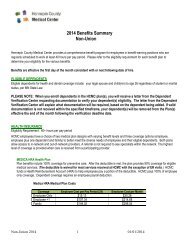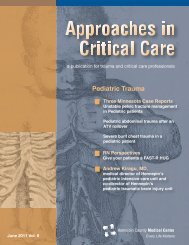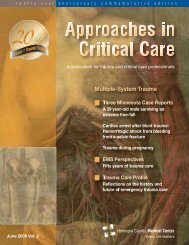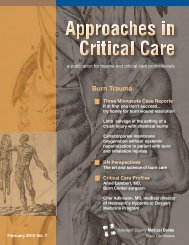Ischemic Stroke - Hennepin County Medical Center
Ischemic Stroke - Hennepin County Medical Center
Ischemic Stroke - Hennepin County Medical Center
You also want an ePaper? Increase the reach of your titles
YUMPU automatically turns print PDFs into web optimized ePapers that Google loves.
EMS Perspectives<br />
________________________________________<br />
Seventy-two percent of patients who have one abnormal finding<br />
on these three exam points may be experiencing an acute stroke.<br />
The patient is considered a possible CVA patient if any of the<br />
tested signs/symptoms are abnormal.<br />
The patient may be a candidate for thrombolysis (intravenous tPA)<br />
if any of the tested signs/symptoms are abnormal and onset of<br />
signs and symptoms began within 3 hours. Patients with ischemic<br />
stroke who are outside of the 3-hour window may be candidates<br />
for intra-arterial tPA or mechanical embolectomy, so timely hospital<br />
care is essential.<br />
Reference. Cincinnati Prehospital <strong>Stroke</strong> Scale (CPSS), Kothari, et al.,<br />
Annals of Emergency Medicine, Volume 33, April 1999. Used with permission.<br />
_____________________________________________________<br />
Figure One. Cincinnati Prehospital <strong>Stroke</strong> Scale for EMS Providers<br />
Transport. Even with the treatment window<br />
being expanded up to 6-12 hours from symptom<br />
onset, faster treatment is always better.<br />
Nearly two million brain cells die during each<br />
minute of a stroke. Rapid and safe transport to<br />
the closest appropriate facility is a key element<br />
of prehospital stroke care. Much like trauma<br />
and cardiac centers, many major hospitals are<br />
developing a “stroke center” model, which<br />
allows for rapid, definitive care of the acute<br />
stroke patient. When patients present with<br />
stroke in areas where a “stroke center” is not<br />
available, transport should be initiated to the<br />
closest facility capable of initial assessment<br />
and referral to a tertiary care center. In areas<br />
where ground transport of an acute stroke<br />
patient will not result in arrival at an appropriate<br />
hospital within the treatment window,<br />
aeromedical evacuation should be considered.<br />
Notification. Like trauma, STEMI, and other<br />
critical patients, it’s important to notify the<br />
receiving facility of an inbound patient with<br />
symptoms of acute stroke. This allows the<br />
facility to notify staff, reserve the appropriate<br />
procedure rooms, and prepare the computed<br />
tomograph (CT) scanner (a head CT is<br />
required prior to the administration of thrombolytics<br />
to ensure that the patient does not<br />
have a cerebral hemorrhage). Because “time<br />
is brain,” early notification of the receiving hospital<br />
allows the hospital-based team to prepare<br />
to reduce the other transitions in care that are<br />
necessary before treatment is started, such as<br />
door-to-CT time, door-to-CT-interpretation<br />
time, and CT-interpretation-to-treatment time.<br />
Because of their critical role in stroke care,<br />
EMS providers have an opportunity to provide<br />
patients with some of the biggest possible<br />
reductions in the time it takes for patients to<br />
be treated. This can be most successful with<br />
rapid response, early identification of acute<br />
stroke, early rule-out or management of hypoglycemia,<br />
and rapid transport to the closest<br />
appropriate facility, along with early notification<br />
to allow the hospital to mobilize resources.<br />
EMS providers may not provide definitive<br />
care, but they make definitive care effective<br />
in acute stroke.<br />
_____________________________________<br />
* The treatments described summarize current practices in<br />
emergency care and serve as a guideline for prehospital care.<br />
EMS providers should defer to their agency’s medical director<br />
and standing orders if there is a discrepancy between this<br />
article and the agency’s current practice.<br />
__________________________________________________<br />
16 | Approaches in Critical Care | December 2008
















